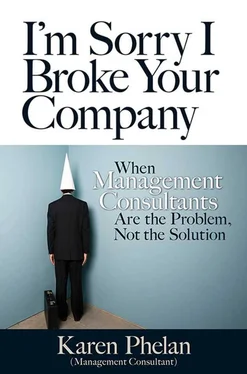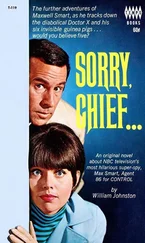Karen Phelan - I'm Sorry I broke Your Company
Здесь есть возможность читать онлайн «Karen Phelan - I'm Sorry I broke Your Company» весь текст электронной книги совершенно бесплатно (целиком полную версию без сокращений). В некоторых случаях можно слушать аудио, скачать через торрент в формате fb2 и присутствует краткое содержание. Город: San Francisco, Год выпуска: 2013, ISBN: 2013, Издательство: Berrett-Koehler Publishers, Жанр: management, popular_business, на английском языке. Описание произведения, (предисловие) а так же отзывы посетителей доступны на портале библиотеки ЛибКат.
- Название:I'm Sorry I broke Your Company
- Автор:
- Издательство:Berrett-Koehler Publishers
- Жанр:
- Год:2013
- Город:San Francisco
- ISBN:978-1-60994-740-8; 978-1-60994-741-5
- Рейтинг книги:3 / 5. Голосов: 1
-
Избранное:Добавить в избранное
- Отзывы:
-
Ваша оценка:
- 60
- 1
- 2
- 3
- 4
- 5
I'm Sorry I broke Your Company: краткое содержание, описание и аннотация
Предлагаем к чтению аннотацию, описание, краткое содержание или предисловие (зависит от того, что написал сам автор книги «I'm Sorry I broke Your Company»). Если вы не нашли необходимую информацию о книге — напишите в комментариях, мы постараемся отыскать её.
I'm Sorry I broke Your Company — читать онлайн бесплатно полную книгу (весь текст) целиком
Ниже представлен текст книги, разбитый по страницам. Система сохранения места последней прочитанной страницы, позволяет с удобством читать онлайн бесплатно книгу «I'm Sorry I broke Your Company», без необходимости каждый раз заново искать на чём Вы остановились. Поставьте закладку, и сможете в любой момент перейти на страницу, на которой закончили чтение.
Интервал:
Закладка:
I got my first taste of this mathematical approach to management on a very large business transformation project. Gemini was working at an underperforming business unit of a huge chemical manufacturer and tasked with improving It's return on equity (ROE). An initial team of consultants had identified ROE as the weak point in the company’s shareholder value drivers, so our main focus was to increase the «productivity of It's assets,» that is, cut costs, and to improve the returns on It's investments. One of the first things we did was set up a huge war room where we hung charts and graphs showing our progress against our savings goals. One of the most impressive charts was a three-foot-wide bar chart labeled «Asset Productivity,» which showed revenues generated per square foot for every facility. Of course, the least productive assets were the sprawling corporate headquarters and a massive research center. Realistically, we couldn’t sell those off, but the chart did teach me an important lesson about consulting. Dividing one measure by another and then plotting the results on a fancy graph impresses clients. That and charting one measure along an x-axis and another along a у-axis, resulting in a quadrant chart, are probably two of the most important consulting skills you can have.
I led a team focused on improving the return on capital expenditures. In the company’s current state, the business unit leaders had the decision-making authority to invest in capital as they saw fit. As part of our consulting intervention, my team put a standard portfolio review process in place where every business would use the same decision criteria and financial analyses to judge capital projects. The goal was to pool capital expenditures across all the business units and then to choose projects with the highest ROI. We developed a decision model that assigned a score based on the strategic value to the company and the financials of the proposed investment, and we implemented a new process for managing capital projects with a series of cross-business-unit meetings to act as gates for selecting the portfolio.
As a dry run, several of the current projects were put through the process. One project stood out like a sore thumb. The newest business unit had a very profitable product line and had been rapidly expanding It's capacity. It had another capital project on the slate. Several executives at headquarters feared that this project would create an overcapacity situation and the profit margins would decrease. Given the rate of expansion in the past, it didn't make sense to build yet another plant. The accepted wisdom on the leadership team was that the business unit head was intent on building an empire at the expense of profits. Using the new capital projects decision model, we calculated the risks involved and the impact on margins and concluded that the plant would not meet the threshold ROI. Of course, the projected revenues were a best guess, but we based our projections on a straight-line increase in the current demand.
The head of this business unit was angry with our result. I considered this conflict to be a test of whether my client could exercise the discipline needed to judge the business units objectively or whether politics would win out, as it often does. I was disappointed to learn several months later that this project had gotten the go-ahead, and I assumed it was because of politics. Years later, though, I learned that my incremental projections for future demand were grossly inadequate. This particular field underwent an immense wave of innovation that spurred all sorts of new applications and end products that couldn’t have been imagined at the time. The actual growth in demand was way off my charts. The company would need lots of additional capacity.
Another team on this project was devoted to developing a new strategy for generating revenue growth and improving market share. They were called the «Strategic Intent/Core Competence» team, based on a new trend in strategy from the Harvard Business School and elaborated on in a book called Competingfor the Future , by Gary Hamel and С. K. Prahalad. The key point of the book was that companies needed to anticipate and shape the future of the industry by building core competencies, a collection of skills unique to that company. For example, Canon used It's competencies in precision mechanics, fine optics, microelectronics, and electronic imaging to expand It's product line from cameras into market leadership in copiers, fax machines, and printers. In many ways, the book was a much-needed antithesis to Michael Porter and the warfare paradigm, where everyone fights over a limited market share. Competing for the Future was about creating new market opportunities and developing unique capabilities, not determining a position based on what your competitors were doing. By building core competencies, companies would have capabilities that their competitors couldn’t replicate easily and would be in a position to control the future and not just react to it. To contrast, Porters work said that the market forces and industry determined what kind of strategic course should be pursued, while Hamel and Prahalad said that internal capabilities should not only determine the strategy but shape the industry. The latter is a very appealing idea because it essentially means you can control your future.
The first step of the SICC team was to determine the clients unique core competencies. Unfortunately, the only area where the client significantly outperformed It's competitors was in performing financial analyses. That couldn’t be leveraged to create a strategy for a manufacturing company. Without finding unique capabilities to leverage into an overarching strategy that would shape the future, the team fell back upon Porter’s methods and embarked on a «differentiation strategy.» The differentiation would be to create a premium product and with it a whole new brand and a new sales channel.
To make a long story short, we consultants walked away from that project contented and excited about having transformed an underperforming business by developing a premium brand, taking out a lot of costs by eliminating assets (including humans), and putting more meaningful decision making into it's capital expenditures. However, in reality, the business continued to underperform, and ten years later it was spun off and sold with the exception of the business unit that had been expanding It's capacity. I don’t know if it was sheer luck or business acumen, but that business-unit head had an insight into his business no one else possessed, and he made the right decision to add capacity, even though the projected numbers didn’t support it. Who could have predicted that so many new end products would be invented? To be honest, we did a terrible job of trying to shape the future. Heck, we couldn’t even predict it accurately.
The problem with these strategic plans is that they require you to predict the future. I have to admit I experienced a perverse sense of enjoyment reading the case examples in my old strategy books. Competing for the Future uses NEC, Motorola, JVC, and EDS as examples of best practices, and what especially amused me was the story of the VCR and how JVC beat Sony to market dominance. Lots of the examples are of Japanese companies because at the time, Japanese companies and the Japanese economy were booming and outperforming American companies in many industries. What struck me about rereading Porter’s book is the emphasis on manufacturing. Although he mentions other industries, most of the examples are about manufacturers, and he frequently mentions building capacity as a strategic maneuver and plants and equipment as barriers to entry and exit. Today, our biggest industries are health care, retail, financial services, and manufacturing, with manufacturing on the decline. Plus, I giggled every time he mentioned «mini-computers.» This isn’t a criticism of Hamel, Prahalad, and Porter. They are brilliant thinkers. It just highlights how difficult it is to predict the future.
Читать дальшеИнтервал:
Закладка:
Похожие книги на «I'm Sorry I broke Your Company»
Представляем Вашему вниманию похожие книги на «I'm Sorry I broke Your Company» списком для выбора. Мы отобрали схожую по названию и смыслу литературу в надежде предоставить читателям больше вариантов отыскать новые, интересные, ещё непрочитанные произведения.
Обсуждение, отзывы о книге «I'm Sorry I broke Your Company» и просто собственные мнения читателей. Оставьте ваши комментарии, напишите, что Вы думаете о произведении, его смысле или главных героях. Укажите что конкретно понравилось, а что нет, и почему Вы так считаете.












